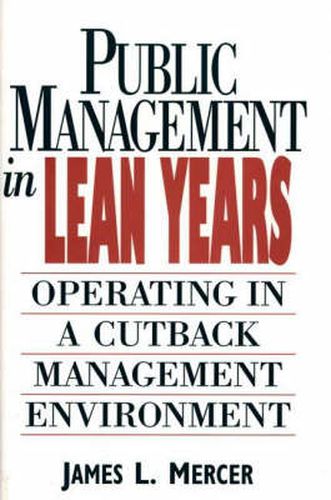Readings Newsletter
Become a Readings Member to make your shopping experience even easier.
Sign in or sign up for free!
You’re not far away from qualifying for FREE standard shipping within Australia
You’ve qualified for FREE standard shipping within Australia
The cart is loading…






Cutback management is a way of life for most public and private sector organisations today, and the factors leading to its presence are expected to be felt well into the 1990’s and beyond. At the same time, organisations are being faced with a changed internal culture where employees want and need to be involved in decisions that affect them. The author explores the trends impacting on state and local governments in the next decade and beyond, describes the cutback management environment that policy and decision makers face, and lays out effective approaches to deal with this environment from the bottom of the organisation upward. In this manner, organisations that identify techniques to improve revenues and reduce costs can find lasting solutions that are accepted at all organisational levels. After reviewing the 15 major trends expected to impact state and local governments during the 1990’s and beyond, the author describes the cutback management environment being faced by most state and local governments. He then describes in detail how to set a direction to address the cutback management environment through the application of strategic planning and goes on to describe how to organise around critical success factors in order to focus resources on achievement of the organisational mission in light of external and internal environmental factors. He explores various techniques for improving employee productivity, ranging from the use of new technology to better management systems to various types of employee involvement. He then discusses the importance of values in the achievement of a shared organisational vision and describes various employee involvement processes that can be used to secure by-in by employees at all levels where organizational changes are underway. Among other issues explored in depth are the use of matrix management to improve productivity in a project-oriented environment and contingency planning to deal with unforeseen events. The book culminates with a description of how to use strategic management as a day-to-day tool for effective bottom-up cutback management, and provides real-life case situations of how state and local governments are effectively dealing with the cutback and involvement processes. This book aims to be of use to state and local government policy and decision makers.
$9.00 standard shipping within Australia
FREE standard shipping within Australia for orders over $100.00
Express & International shipping calculated at checkout
Cutback management is a way of life for most public and private sector organisations today, and the factors leading to its presence are expected to be felt well into the 1990’s and beyond. At the same time, organisations are being faced with a changed internal culture where employees want and need to be involved in decisions that affect them. The author explores the trends impacting on state and local governments in the next decade and beyond, describes the cutback management environment that policy and decision makers face, and lays out effective approaches to deal with this environment from the bottom of the organisation upward. In this manner, organisations that identify techniques to improve revenues and reduce costs can find lasting solutions that are accepted at all organisational levels. After reviewing the 15 major trends expected to impact state and local governments during the 1990’s and beyond, the author describes the cutback management environment being faced by most state and local governments. He then describes in detail how to set a direction to address the cutback management environment through the application of strategic planning and goes on to describe how to organise around critical success factors in order to focus resources on achievement of the organisational mission in light of external and internal environmental factors. He explores various techniques for improving employee productivity, ranging from the use of new technology to better management systems to various types of employee involvement. He then discusses the importance of values in the achievement of a shared organisational vision and describes various employee involvement processes that can be used to secure by-in by employees at all levels where organizational changes are underway. Among other issues explored in depth are the use of matrix management to improve productivity in a project-oriented environment and contingency planning to deal with unforeseen events. The book culminates with a description of how to use strategic management as a day-to-day tool for effective bottom-up cutback management, and provides real-life case situations of how state and local governments are effectively dealing with the cutback and involvement processes. This book aims to be of use to state and local government policy and decision makers.